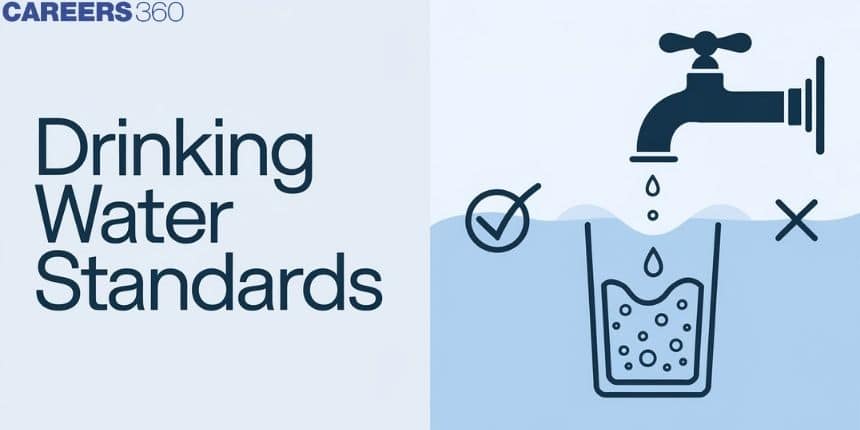Drinking Water Standards and Quality Guidelines
Water is one of the resources that sustains life, but its quality varies greatly due to a host of factors including geographical location, environmental conditions, and human activities. In view of increasing Pollution, climate change, and urbanization, the importance of standards related to drinking water becomes quite critical. These are standards that have been set by health institutions and regulatory bodies, ensuring that, indeed, drinking Water does not contain any harmful contaminants.
This Story also Contains
- International Standards for Drinking Water
- Some Solved Examples
- Summary

International Standards for Drinking Water
The International Standards for drinking water are given below and they must be followed.
Fluoride:
For drinking purposes, water should be tested for fluoride ion concentration. Its deficiency in drinking water is harmful to man and causes diseases such as tooth decay etc. Soluble fluoride is often added to drinking water to bring its concentration up to 1 ppm. However, F- ion concentration above 2 ppm causes brown mottling of teeth. At the same time, excess fluoride (over 10 ppm) causes a harmful effect to bones and teeth.
Lead:
Drinking water gets contaminated with lead when lead pipes are used for the transportation of water. The prescribed upper limit concentration of lead in drinking water is about 50 ppb. Lead can damage the kidneys, the liver, the reproductive system, etc.
Sulphate:
Excessive sulphate (>500 ppm) in drinking water causes a laxative effect, otherwise at moderate levels it is harmless.
Nitrate:
The maximum limit of nitrate in drinking water is 50 ppm. Excess nitrate in drinking water can cause diseases such as methemoglobinemia (‘blue baby’ syndrome).

Recommended topic video on (Drinking Water Standards)
Some Solved Examples
Example 1
Question:
Which of the following statements is (are) incorrect reason for eutrophication?
(A) excess usage of fertilizers
(B) excess usage of detergents
(C) dense plant population in water bodies
(D) lack of nutrients in water bodies that prevent plant growth
Choose the most appropriate answer from the options given below:
1) (D) only
2) (B) and (D) only
3) (A) only
4) (C) only
Solution:
The excess usage of detergents and fertilizers leads to eutrophication, which causes water pollution and kills animal life by depriving it of oxygen. A dense plant population in water bodies is a consequence of eutrophication, not a cause. The incorrect statement is (D) because eutrophication is caused by an excess of nutrients, not a lack of them. Hence, the correct answer is option (1).
Example 2
Question:
Given below are two statements:
Statement I: Non-biodegradable wastes are generated by thermal power plants.
Statement II: Bio-degradable detergents lead to eutrophication.
In light of the above statements, choose the most appropriate answer from the options given below:
1) Both Statement I and Statement II are false
2) Both Statement I and Statement II are true
3) Statement I is false and Statement II is true
4) Statement I is true and Statement II is false
Solution:
Non-biodegradable wastes, such as fly ash, are indeed generated by thermal power plants. Biodegradable detergents can lead to eutrophication because the bacteria that degrade these detergents use up oxygen in the water, depriving other aquatic life of oxygen. Hence, both statements are true. The correct answer is option (2).
Example 3
Question:
Which of the following elements causes damage to the kidney and liver when they are present more than their tolerance limit?
1) Cd
2) Hg
3) Ni
4) All of these
Solution:
Cadmium (Cd), mercury (Hg), and nickel (Ni) are all heavy metals that can cause damage to the kidney and liver when present above their tolerance limits. Hence, the correct answer is option (4) - all of these.
Example 4
Question:
Eutrophication leads to:
1) depletion of dissolved oxygen in water
2) death of animals
3) depletion of ozone
4) Only 1 & 2
Solution:
Eutrophication leads to the depletion of dissolved oxygen in water due to the decomposition of excessive plant matter, which in turn causes the death of animals. It does not affect ozone levels. Hence, the correct answer is option (4) - only 1 & 2.
Summary
The paper discussed very important drinking water standards: what they were and what parameters established the quality of the water. We went through the various types of contaminants from microbial, chemical to physical parameters that state the permissible limits set for each. We also got to learn about its relevance in real life through its impacts on public health, environmental sustainability, and community engagements.